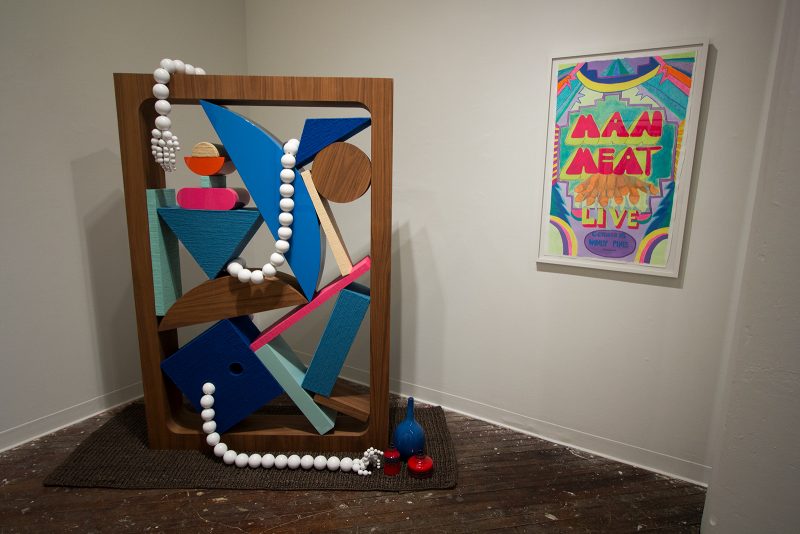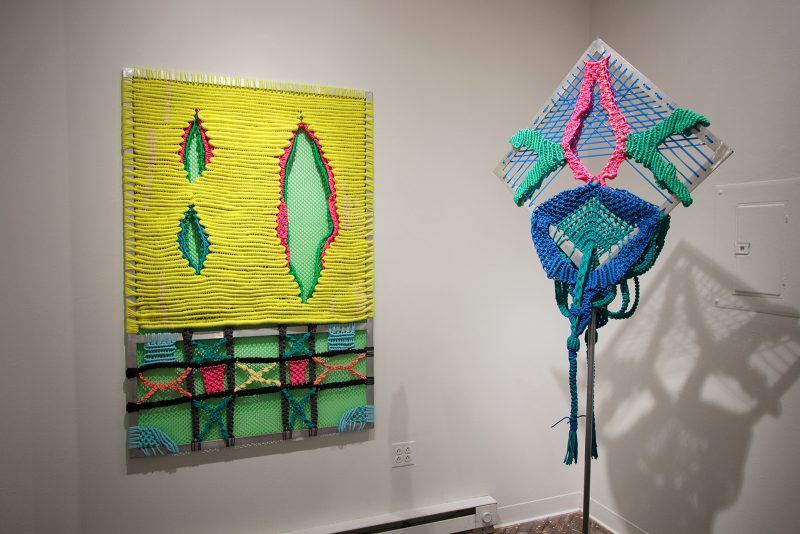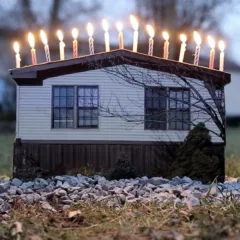In Two Spiders at Grizzly Grizzly, artists Chris Bogia and Jesse Harrod each use multiple media—sculpture, textile, drawing, painting—to present their own interpretations of the “sensual” qualities of a queerness that, as their show’s online blurb says, can be “both strange and gay.” The works themselves are largely dynamic and eye-catchingly colorful, even campy at times — filled with jokes and biting visual wit. There’s genitalia both explicitly drawn and more slyly evoked; when I walked into Grizzly Grizzly’s small gallery space in the 319 North 11th Street building, I remarked to myself that I was going to be using the words “penis” and “vagina” more than I typically do in my writing, if only to describe what was on display.

In a two-person show like this one there’s a tendency, at least on my end, to compare and contrast: to see how each artist uses their own works, mingled amongst each-other, to create a coherent narrative or satisfying rhythm. With regards to Two Spiders, then, I found that each artist brought something totally different to the table: while Harrod’s sculptures and drawings were cheeky and raunchy in glorious technicolor, Bogia’s large-scale sculpture and three small, deceptively-simple drawings cohesively “queer” the forms depicted in them.
Playing with expectations
Bogia’s delicate triptych on the left-most wall — called (Untitled) Plants vs. Zombies — is particularly remarkable in its citation of calligraphic forms and elegant Persian court painting to represent sinuous, disembodied arms grasping towards plants, within a kind of arched-window frame. In Plants vs. Zombies we see a pure distillation of “queering” as subversive—in the way Bogia undermines the royal, sophisticated compositions of these drawings by populating them with cut-off zombie arms. The grotesquerie of the arms and hands comes into the space and alters it, thwarting our expectations of a formal language we recognize to create something comical and surreal — and it’s all well and subtly done.
Diagonally across the room, Bogia’s arresting sculpture, The Decorator, continues visual elements of Plants vs. Zombies. Composed of wood, steel, lacquer, a rug, vases, paint, and other industrial materials, The Decorator is, at first glance, reminiscent of 1970s interior design. The wooden frame encasing the brightly-colored geometric components recalls the wood panelling and tacky furniture that defined the living rooms of that decade. Woven through the work, from top to bottom, is what appears to be a sized-up facsimile of a strand of pearls capped off on each end with pearl-skeletal hands — a clear reference to the hands of Plants vs. Zombies. The hand at the bottom continues that reaching motion, stretching towards a red vase laid out on the rug, while the hand at the top rests limply, relaying the exhaustion that logically follows the exertions in Bogia’s works. Despite being totally different from his other work in media and scale, The Decorator provides a conclusion to the mini-narrative that Bogia weaves in Two Spiders.

Fun with anatomy
Jesse Harrod’s three sculptures and two drawings pick up the thread of Bogia’s works in their own way, although they come across as a bit disjointed as a body of works. If the curving forms of Bogia’s arms resemble one thing, it’s snakes, which (thanks to Freud) have been phallic symbols in art for centuries. As we move from Bogia to Harrod, we are rewarded with actual penises in the mixed-media drawing Man Meat, which is placed across from Harrod’s other drawing in the show, Tiny Vaginy, whose sole figure leans back and presents us (and, layout-wise, the penises of Man Meat) its vagina.
The most intriguing of Harrod’s untitled sculptures in Two Spiders, which are composed of paracord woven within aluminum frames, also gets in on the genitalia-related fun and, quite possibly, into the realm of camp and queer iconography. Set within the rectangular frame, four drooping yellow-orange forms emerge from a pinky-red ground, topped with a denser weaving of blue-green paracord. After I got the phallic connotations of the droopy shapes out of my head, I found that they quite reminded me of the way the Wicked Witch of the East’s legs curl and shrivel under Dorothy’s fallen farmhouse in The Wizard of Oz, a film that has been read as containing queer themes. It’s potentially a stretch, but perhaps the neatness of Bogia’s work primed me to look for these kinds of references and nods to queer history.

Ultimately, Two Spiders functions as a reminder that queerness is complex — that not every queer person’s experience of and relationship to their identity will look the same, despite the inoffensive, homogenous way queerness is depicted in more mainstream settings. Queerness has an aesthetic tradition (or traditions) of its own, which the variety of moods generated by Harrod and Bogia’s works convey with humor and verve.
Two Spiders is on view through Sunday May 27th, for more information about the show, visit the Grizzly Grizzly website.









